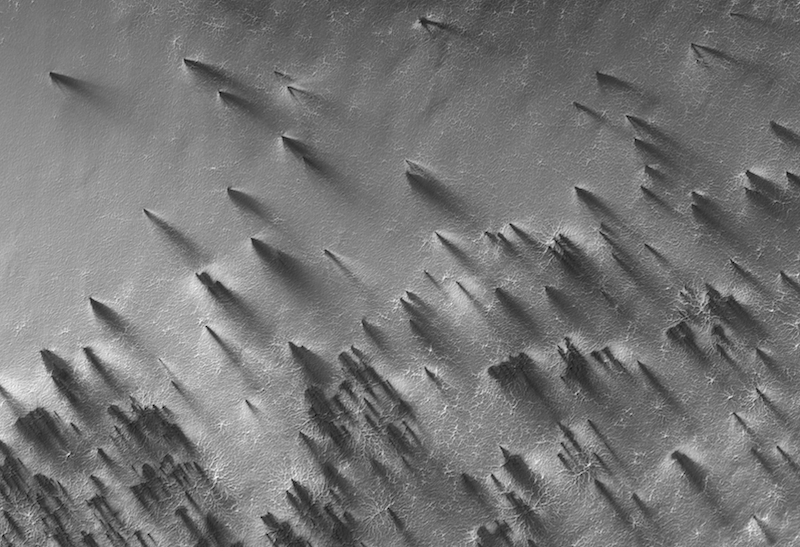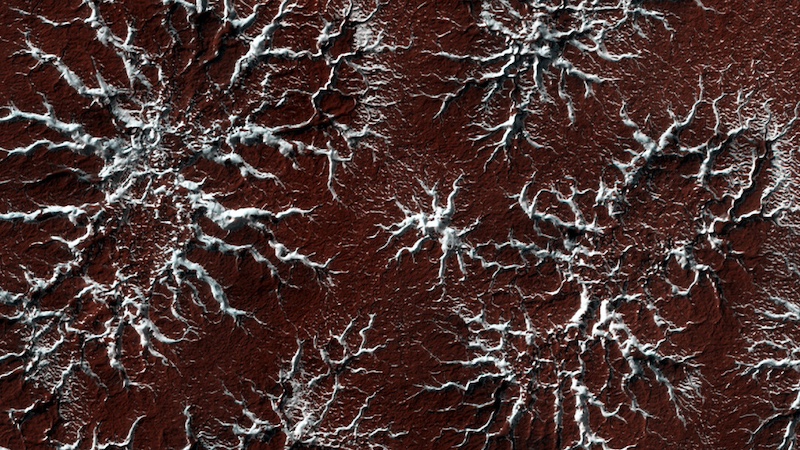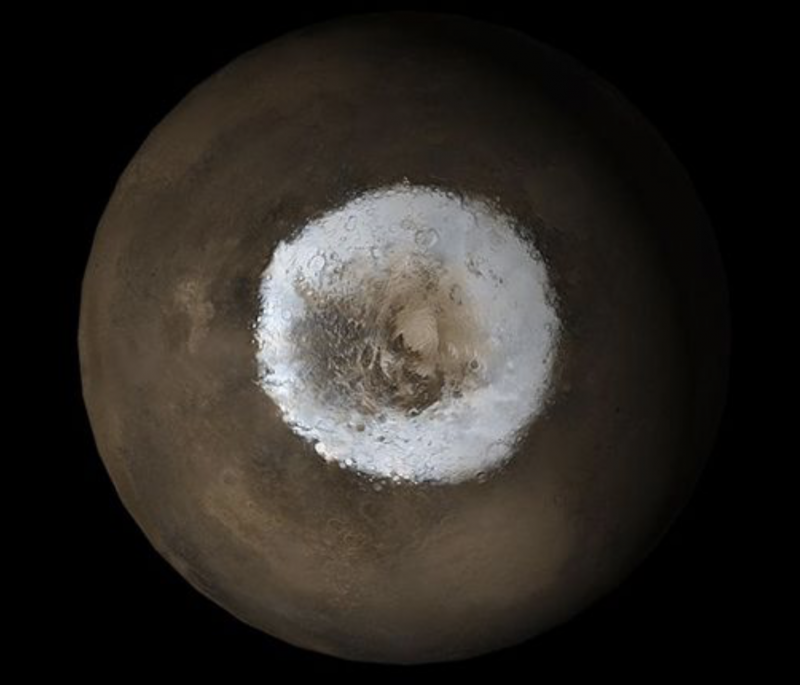- Mars has two polar ice caps, at the North Pole and South Pole. They are composed primarily of carbon dioxide ice.
- There are some interesting differences between them, even though they are generally similar. Carbon dioxide reacts differently with the Martian surface at each pole. Why?
- A new study shows how Mars’ eccentric orbit, the length of seasons and differences in terrain all play a role.
Mars’ polar caps: similar but different
Mars has bright polar ice caps, which you can see even in small telescopes. You can watch them grow and shrink with the seasons. Unlike on Earth, they consist mostly of frozen carbon dioxide. On September 1, 2024, a team of scientists led by the Planetary Science Institute discussed their new research about the planet’s polar caps. The results help explain why the polar caps have similarities and differences.
The new study combines past observations with newer ones from NASA’s Mars Reconnaissance Orbiter (MRO). The spacecraft used its High-Resolution Imaging Experiment, or HiRISE, camera, to image the polar regions in incredible detail.
The researchers published their peer-reviewed findings in the journal Icarus on September 1, 2024.
Mars’ eccentric orbit
The study focused on how carbon dioxide is cycled between the polar caps and the atmosphere. This happens at both poles but not exactly in the same way. Lead author Candice Hansen of the Planetary Science Institute explained:
Everybody knows there’s a difference in how carbon dioxide interacts with the poles, but how many people understand why? That was what I was setting out to describe. And fortunately, I have a whole bunch of really talented co-authors who were willing to fill in their own pieces.
The answer largely has to do with Mars’ orbit. Being farther from the sun than Earth, Mars takes about twice the time to complete an orbit as Earth does. Its orbit is also more oblong, or eccentric, as scientists say. By comparison, Earth’s orbit is more circular. This somewhat oblong orbit also affects Mars’ seasons. Mars has four seasons, just like Earth. But the eccentric orbit means that the seasons are unequally long.
During its orbit around the sun, Mars is farthest from the sun when in fall and winter in the southern hemisphere, and spring and summer in the northern hemisphere. Correspondingly, those seasons in each hemisphere are the longest.

Southern fall and winter are the coldest
Surface elevation also plays a role. Because the southern hemisphere overall is more elevated, it has lower atmospheric pressure than the northern hemisphere lowlands. It is also, therefore, colder in winter than the northern hemisphere. In fact, about a quarter of the atmosphere freezes out onto the surface as carbon dioxide ice each year. Hansen said:
So ultimately, southern fall and winter bring the most freezing and lowest atmospheric pressure. These are the major drivers of differences in seasonal behavior of carbon dioxide between the hemispheres.
Dust storms in northern hemisphere
So overall, winters in the northern hemisphere are just a bit warmer than in the southern hemisphere. Another reason for this is dust. The winter season coincides with dust storm season, another annual feature of the Martian atmosphere. There is a lot of dust swirling around in the northern hemisphere – and the entire planet – at this time. And because it is winter, with a growing ice cap, there is more dust trapped in the north polar ice cap than in the south. This is another way the two ice caps differ from one another. Or as Hansen said:
They’re not symmetric seasons.

Dust fans at Mars’ South Pole
The terrain itself also has an impact on how the carbon dioxide cycle affects the landscape at each pole. At the South Pole, the terrain is relatively flat. So even though there is less dust overall in the winter than in the north, that dust is spread out in dark fans on the surface by winds.
How do the fans form? The process starts with the carbon dioxide ice, as Hansen explained:
A layer of carbon dioxide ice builds in the southern hemisphere fall, and over the course of the winter, it thickens and it becomes translucent. Then in the spring, the sun comes up, and light penetrates this ice layer to the bottom enough that it warms up the ground underneath.
Because the ground is bit warmer now, the carbon dioxide ice sublimates, that is, it turns directly into a gas. That gas then wants to escape the ice it’s trapped under. Hansen added:
Now, gas is trapped under pressure. It’s going to look for any weak spot in the ice and rupture like a champagne cork.
This rupturing creates gullies in the surface. But unlike most gullies, these are splayed out from a center point. These are the famous Martian spiders. Once the gas erupts out onto the surface, the dark dust in it gets blown outward by winds, creating the fans. Hansen said:
It turns out that meteorology is really important in this picture too, because from there, the dust is blown by whatever wind happens to be present and lands in a fan-shaped deposit.

Sand dunes at the North Pole
By comparison, the same kind of dust fans do also occur at the North Pole. However, the terrain there is different. Instead of just mostly a flat landscape, there are vast fields of sand dunes. This affects the sublimation process. As Hansen explained:
When the sun comes up and begins to sublimate the bottom of the ice layer, there are three weak spots. One at the crest of the dune, one at the bottom of the dune where it meets the surface and then the ice itself can crack along the slope. No araneiform [spider-like] terrain has been detected in the north because although shallow furrows develop, the wind smooths the sand on the dunes.
The results help shed new light on current processes on Mars, not just ones from the ancient past. The planet may not be as geologically active now as it used to be, but it is still active, as Hansen noted:
Most of my colleagues study the changes that happened on Mars 3.5 billion years ago, but I’m talking about things that happened last month. Mars is active today.
Bottom line: Mars’ polar caps are generally similar, but they also differ in some some aspects. A new study shows how the sublimation of carbon dioxide ice plays a key role.
Source: A comparison of CO2 seasonal activity in Mars’ northern and southern hemispheres
Via Planetary Science Institute
Read more: Liquid water on Mars beneath polar ice?
Read more: Ancient ice sheets found under Mars’ north pole